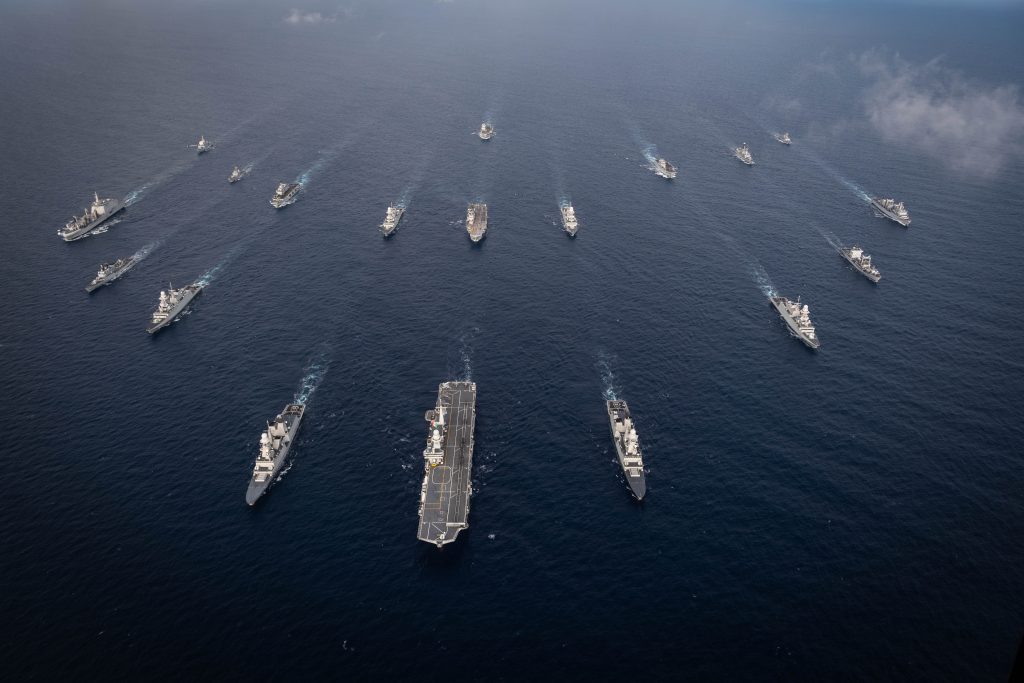Started on April 13th, the first of the two annual editions of the most important training cycle of the Navy called Open Sea ended on May 6th, an articulated and complex training gym with a strong multi-domain and multi-threat connotation that sees the real use of the entire fleet in a challenging simulated scenario, inspired by maximum realism. A flexible and modular training model, constantly refined over the years and perfectly tailored to the needs of use of the Navy defined by its Chief of Staff, Admiral Enrico Credendino.
This edition was characterized by a massive use of personnel, about 6,000 soldiers, means and capabilities of the Italian Navy. To integrate the forces in the field, also this year, a significant multinational presence, with 23 nations – 13 NATO and 10 Partners – representing 5 continents, which participated with ships, maritime patrol aircraft, specialized teams for mine countermeasures and also a high mobility artillery battery for amphibious maneuver (High Mobility Artillery Rocket System – HIMARS).
Equally consolidated is the inter-force support of components of the Italian Army, integrated into the Italian Navy Landing Force which, together with departments of the Serenissima Lagoon Regiment, have achieved the Initial Operational Capability Plus of the National Sea Projection Capacity (CNPM) with the enabling support of the multidimensional and multidisciplinary capabilities of the naval force. Coordinated training interactions were also developed with vehicles and personnel of the Italian Air Force, whose aircraft enriched the air defense training events, the Carabinieri, for the development of environmental monitoring training events, and the Guardia di Finanza, for joint activities in the field of law enforcement in the maritime dimension.
The incessant contribution that the Navy provides for the protection of navigation safety has continued even during training activities, in fact the minehunter units engaged in the Open Sea have located and proceeded to render harmless 6 devices dating back to the Second World War.

The exercise activities also included issues related to the protection of the maritime environment and the rescue of populations affected by natural disasters, with the collaboration of Civil Protection personnel for the preparation of an Advanced Medical Post on the island of La Maddalena. Also in this important and fruitful edition was the participation of various interinstitutional and interagency realities including the Center for International Studies (Ce.Si.), the Center for Studies of Geopolitics and Maritime Strategy (CESMAR), the Corps of Volunteer Nurses of the Italian Red Cross and students and teachers from prestigious national universities as well as trade associations falling within the maritime cluster such as Confitarma and Assarmatori.
“The Open Sea, from the 80s to today – highlighted Admiral De Carolis, commander in chief of the Naval Squadron – has become a recognized training gym at international level and this is demonstrated by the levels of participation – in number and valuable skills involved – in terms of multinational interoperability, inter-force integration, interinstitutional coordination and interagency collaborations ” continuing then “the intense weeks of activity, in which the executive phase of the exercise was developed, crowned the equally demanding planning phase, which began last November, in continuity with the end of the previous autumn edition of Mare Aperto.
Since 13 April and until today all levels of command of the Naval Squadron, which include staff and naval units, have shown the ability to operate individually and in synergy as a team” and concluding “from this year, then, in the challenging training test bench typical of the Open Sea, we have also introduced the development of a specific activity concerning the cyber domain and its security called Chironex 23‐1; confirming the interest that the Navy has always directed to the spatial and cybernetic dimensions to which it has faced, since the 80s of the last century for the need to ensure telecommunications and connectivity to units at sea”.

Follow us on our Telegram channel

